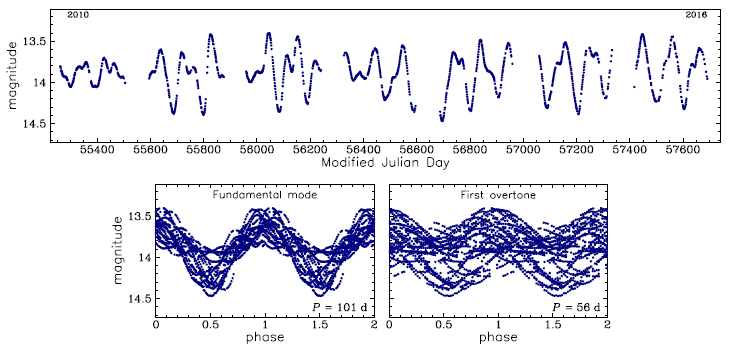Semiregular Variables
Semiregular variables (SRVs) are asymptotic giant branch stars or red supergiant pulsating stars with periods from about 30 to 500 days. As the name suggests, their light curves exhibit both periodic and irregular behavior. Moreover, even the cyclic variations usually show large phase and amplitude fluctuations. Note also that some SRVs exhibit long secondary periods. Typical light curves of SRVs are presented in the pictures below. Left panels show unfolded light curves collected during the first 5 years of the OGLE-IV survey (2010-2014). Right panels show the same light curves folded with the primary (the largest-amplitude) period.
Some SRVs display persistent periodicities with relatively large amplitudes of light changes (in the General Catalogue of Variable Stars, GCVS, they are classified as SRa stars), while others (dubbed SRb stars) have poorly defined periodicities or show alternating intervals of periodic and irregular changes. The GCVS distinguishes two additional subclasses of SRVs: semiregular red supergiant stars (SRc variables) and yellow semiregular variables (SRd stars). The latter type is closely related to RV Tauri stars.
In the classical approach, SRa stars are distinguished from Mira variables by their visual peak-to-peak light amplitudes of less than 2.5 magnitudes. However, there is no natural break in the amplitudes between these two types of long period variables, especially that many of them randomly change their amplitudes, so the same star may be classified as a Mira or as a SRV, depending on the observation time span. The essential difference between SRVs and Miras lies in the number of excited pulsation modes. The vast majority of SRVs are double-mode pulsators with the fundamental mode and first overtone simultaneously excited, so they occupy two ridges in the period-luminosity diagram: sequences C and C'. The upper panel in the picture below shows an unfolded light curve of a typical SRV observed by the OGLE survey in the Galactic bulge. The lower panels present the same light curve folded with periods associated with the fundamental mode (left panel) and first-overtone mode (right panel).
 |
The ratios of the pulsation periods in SRVs range from about 0.5 to 0.7. Here is one more example light curve of a SRV from the OGLE Collection of Variable Stars.
| 